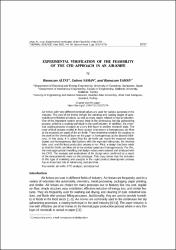Experimental verification of the feasibility of the CFD approach in an air-knife
Künye
Altay, R., Yaman, G., & Yaman, R. (2022). Experimental Verification of the Feasibility of the Cfd Approach in an Air-Knife. Thermal Science, 26, ss. 727–734. https://doi.org/10.2298/TSCI22S2727AÖzet
Air knives with very different nominal values are used for various purposes in the industry. The uses of air knives include the painting and coating stages of automobile semi-finished products, as well as many stages related to food production. One of the important sectors among these is the continuous hot-dip galvanizing process, which is a coating technique in the steel industry. In addition, the chemical coating process on paper as a very thin layer is another research topic. The most critical process needed in these sectors is to ensure a homogeneous air-flow at the expected air speed of the air-knife. These determine whether the coating on the steel or the chemical layer on the paper is homogeneous at the desired thickness. In this study, it is aimed that the air-knife can reach the expected values (speed and homogeneous distribution) with the expected tolerances, the shortest time, cost, and the least production process error. First, a design has been made so that this knife can blow air at the desired speed and homogeneously. For this, the most appropriate modeling and design values were created and analyzed with the CFD. The analysis and evaluations of the design were confirmed as a result of the measurements made on the prototype. This study shows that the inclusion of this type of modeling and analysis in the rapid product development process has an important role in minimizing cost and time.

















